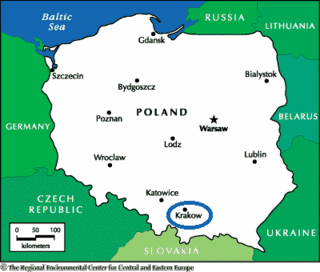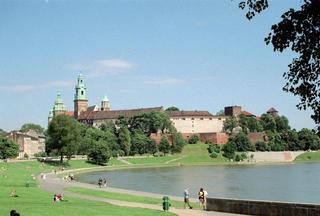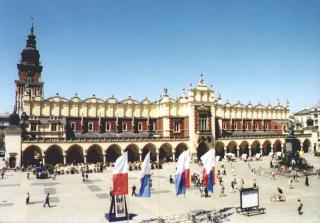History of Kraków

The earliest known settlement on the present site of Kraków was established on Wawel hill, and dates back to the 4th century. Legend attributes the town's establishment to the mythical ruler Krak, who built it above a cave occupied by a ravenous dragon.
Before the Polish state existed, Kraków was the capital of the tribe of the Vistulians, probably linked to the larger polity of Greater Moravia. Kraków's first appearance in historical records dates back to the 8th century, and notes that the prince of the Vistulians was baptized. The first mention of the name dates to 966, when Abraham ben Jacob mentioned it as a notable commercial centre.
After Greater Moravia was destroyed by the Hungarians, Kraków became part of the kingdom of Bohemia. By the end of the 10th century, the city was a major center of trade. Around this time, it was incorporated into the holdings of the Piast dynasty of Poland. Several brick buildings were also constructed, including a castle, Romanesque churches, a cathedral, a basilica, and the St. Felix and Adaukt Church.
In 1038, Kraków became the seat of the Polish government. Two hundred years later, it was almost entirely destroyed in the Tatar invasions.
In 1257, the city was rebuilt, in a form which has remained practically unaltered, and received city rights under Magdeburg Law. 1311 saw a rebellion agaist Wladislaus I of Poland. Rebellion was organised by Albert and consisted mostly of German-speaking citizens in Kraków. The rebellion cost Poland the city of Gdańsk, which was taken by the Teutonic Orders, but German-speakers lost their political ambitions and began to Polonize.
Kraków rose to new prominence in 1364, when Casimir III of Poland founded the University of Kraków, the second in central Europe after the University of Prague. There had been a cathedral school under the auspices of the city's bishop since 1150. The city continued to grow under the Lithuanian Jagiello dynasty (1386-1572), which maintained close connections to the imperial house of Habsburg of the Holy Roman Empire. As the capital of a powerful state, it became a flourishing center of science and the arts. Many works of Renaissance art and architecture were created here during that time.
In 1475 delegates of the elector George the Rich of Bavaria came to Kraków to negotiate the marriage of Hedwig, the daughter of King Casimir IV Jagiello to George the Rich. Hedwig traveled for two months to Landshut in Bavaria, where an elaborate marriage celebration, the Landshut Wedding (Landshuter Hochzeit) took place.
Renaissance
In 1488 the imperial Poet Laureate and humanist Conrad Celtes founded the Sodalitas Litterarum Vistulana, a learned society based on the Roman Acadiemies. In 1489 Veit Stoss of Nuremberg finished his work on the Great Altar of the St. Mary's Church. He later also wrought a marble sarcophagus for Casimir IV. Numerous other artists, mainly from Nuremberg, worked in Kraków. By 1500, Haller had established a printing press in the city.
In 1520, Johan Behem made the largest churchbell in Poland, named the Sigismund Bell after king Sigismund I. At the same time Hans Dürer, younger brother of Albrecht Dürer, was Sigismund's court painter. Hans von Kulmbach made the altar for the Johannis Church.
Decline
In 1572, the king Sigismund II died childless, and the throne passed to Sigismund III of the Swedish House of Vasa. Kraków's importance began to decline, accelerated by the pillaging of the city during the Swedish invasion, and an outbreak of plague that left 20,000 of the city's residents dead. Sigismund III moved his capital to Warsaw in 1596.
After the partition of Poland
In the late 18th century, the weakened Polish state was absorbed by its more politically vigorous neighbors, Russia, Austria, and Prussia. Kraków became part of the Austrian province of Galicia. Tadeusz Kościuszko initiated a revolt, the Kościuszko insurrection, in Kraków's market in 1794. The Prussian army put down the revolt, and looted Polish royal treasure kept in the city.
When Napoleon Bonaparte of the French Empire captured what had once been Poland, he established the Duchy of Warsaw (1809) as an independent but subordinate state. The Congress of Vienna (1815) restored the partition of Poland, but gave Kraków its independence, as the Free City of Kraków. The city again became the focus of a struggle for national sovereignty in 1846, during the Kraków Uprising. The uprising failed to spread outside the city to other Polish-inhabited lands, and was put down, resulting in Kraków's annexation by Austria.
After the Austro-Prussian War of 1866, Austria granted autonomy to Galicia, making Polish a language of government and establishing a provincial diet. As this form of Austrian rule was more benevolent than that exercised by Russia and Prussia, Kraków became a Polish national symbol and a center of culture and art. Famous painters, poets and writers of this period include Jan Matejko, Stanisław Ignacy Witkiewicz, Jan Kasprowicz, Juliusz Kossak, Wojciech Kossak Stanisław Wyspiański, and Stanisław Przybyszewski. The latter two were leaders of Polish modernism.
20th century
During the First World War, Kraków Legions led by Jozef Pilsudski set out to fight for the liberation of Poland, in alliance with Austrian and German troops. The Austrians and Germans lost the war, but the terms of the Treaty of Versailles (1919) established the first sovereign Polish state in over a century.
Poland was partitioned again in 1939, at the outset of the Second World War, and Nazi German forces entered Kraków in September of that year. It became the capital of the General Government, a colonial authority under the leadership of Hans Frank. The occupation took a heavy toll, particularly on the city's cultural heritage. On one occasion, over 150 professors and other academics of the Jagiellonian University were summoned to a meeting, arrested and dispatched to the concentration camp at Sachsenhausen (see also Sonderaktion Krakau). Many relics and monuments of national culture were destroyed or looted. Major concentration camps near Kraków included Plaszow and Auschwitz, which many Polish Jews were sent to.
Thanks to a manoeuvre by advancing Soviet forces, Kraków escaped complete destruction during the German withdrawal and some historic buildings and works of art were saved. After the conclusion of the war, however, the government of the People's Republic of Poland ordered the construction of the country's largest steel mill in the suburb of Nowa Huta. This is regarded as an attempt to diminish the influence of Kraków's intellectual and artistic circles by attracting the working class.
Kraków's population has quadrupled since the end of the war, and it is still regarded as the cultural capital of Poland. In 1978, UNESCO placed Kraków on the list of World Heritage Sites.
Look also at two pictures of Kraków:
1. on the first you can see Wawel castle nearby Vistula river (Vistula is the biggest Polish river)

2. on the second you can admire Sukiennice - very old, big and famous souvenir shop on the city market

It is also worthy to mention that Kraków is really charming city - full of relics, nice pubs, parks, little alleys. It is a city of bards, poets and painters and soon I will show you much more pictures to prove it:)

0 Comments:
Post a Comment
<< Home